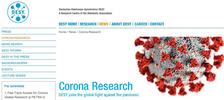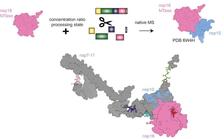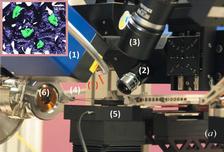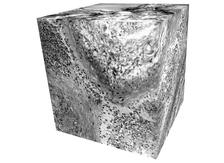Coronaviruses (CoV) belong to a large family of viruses responsible for illnesses ranging from the common cold to more severe diseases.The virus SARS-CoV-2 causes the infectious COVID-19 disease.
DESY contributes to the worldwide intensive research for fighting the pandemic. For more than two years, until June 2022, DESY offered also fast track access for scientific users from academia or industry to perform research related to the fight of the COVID-19 pandemic at DESY light sources and facilities. This research, as well as on other viruses, is being continued at DESY's light sources.
Major investigations done at the light source PETRA III and at DESY have already completed and published.
Please find below a selection of research activities at DESY or of DESY resarchers since March 2020:
Comparing polyprotein processing in four human coronaviruses revealed distinct and common features like delayed cutting between nsp7 and nsp8. AlphaFold3 models (here SARS-CoV-2 nsp7-11) showed that this cleavage site can form a helix. The methyltransferase nsp16 binds nsp10 depending on the virus even prior release from the polyprotein (from news). (Image: Kira Schamoni-Kast)
New insights into the mechanisms of human coronaviruses revealed | Laboratory studies
Scientists have discovered new details about how coronaviruses make copies of themselves inside human cells. They studied how the virus splits long protein chains into smaller parts, which then come together to form the virus’s replication machine. Understanding this process better can help develop new treatments to stop the virus from spreading.
Coordination: C. Utrecht (Univ. Lübeck/DESY)
Publication: K. Schamoni-Kast, B. Krichel, T. Damjanović, F.-A. Said, T. Kierspel, S. Toker, C. Uetrecht, The kinetics of nsp7-11 polyprotein processing and impact on complexation with nsp16 among human coronaviruses, Nat Commun (2025) DOI: 10.1038/s41467-025-61554-y
The team members were keeping their social distance in the experimental hutch of the PETRA III beamline P23 during their beamtime in August 2020. (Left to right): R. D. Harvey (Univ. Vienna), C. Wölk (Univ. Leipzig), C. Shen (DESY), G. Bello (Univ. Vienna), and remotely J. Torres (Nanyang Tech. Univ.). (Credit: DESY)
The physics behind the capsulation of the coronavirus | X-ray studies at PETRA III
Already since the very beginning of the pandemic, an international team of scientists from DESY, Leipzig University (Germany), University of Vienna (Austria) and Nanyang Technological University (Singapore) has focused on the encapsulation process of the SARS-CoV-2 virus inside the infected cell and has now uncovered the physical mechanism behind this process. This was made possible by fast-track access to beamtime at DESY’s light sources to advance SARS-CoV-2 research.
Coordination: Chen Shen (DESY)
Publications: Wölk, C.; Shen, C.; Hause, G.; Surya, W.; Torres, J.; Harvey, R. D.; Bello, G. Membrane Condensation and Curvature Induced by SARS-CoV-2 Envelope Protein, Langmuir (2024), 40 (5), 2646-2655. DOI: 10.1021/acs.langmuir.3c03079.
Harvey, R. D.; Bello, G.; Kikhney, A. G.; Torres, J.; Surya, W.; Wölk, C.; Shen, C. Absolute scattering length density profile of liposome bilayers obtained by SAXS combined with GIXOS: a tool to determine model biomembrane structure. J Appl Crystallogr (2023), 56 (6). DOI: 10.1107/S1600576723008439.
Experimental set-up for the screening of samples at the PETRA III beamline P11. (Photo: M. Mayer, DESY)
Drug screenings | Macromolecular crystallography at PETRA III
The research team from Fraunhofer Institute for Molecular Biology and Applied Ecology (IME), Univ. Hamburg, Univ. Lübeck, Bernhard-Nocht-Institut (BNITM) and DESY performs experiments at the PETRA III beamlines P11 and P13-P14 (both EMBL) and focuses on the three key proteins of the pathogen as possible drug targets. Over 5600 active substances werde provided by Fraunhofer IME. About 5770 samples with nearly 3900 different active compounds were already screened until 23 April 2020, whereof 13 substances were identified which bind to a viral protein.
Coordination: Alke Meents (DESY)
Publication: Günther, S. ; Reinke, P. Y. A. ; Fernández-García, Y. et al.: X-ray screening identifies active site and allosteric inhibitors of SARS-CoV-2 main protease (2021) Science, Vol 372, 642-646. 10.1126/science.abf7945
Typical setup at the PETRA III beamline P03 for in situ X-ray scattering experiments of virostatic drug delivery.
Inset: Determined structure of drugs in codrugs. (Source and further information).
Mechanisms of Antiviral Medication | In-situ X-ray scattering at PETRA III
The research team from KTH Stockholm (Sweden) and DESY investigates various low-dose drug delivery options for local, antiviral medication of drugs with severe medical side effects and which therefore require careful dosing. Modern Lambda Medipix-based detectors are used at the PETRA III beamline P03 essential for high-speed and high-resolution investigations, at the same time greatly enlarging the q-range.The studied drugs include selected examples of the SOLIDARITY project launched by the WHO against the SARS-CoV-2 virus.
Coordination: Simone Techert and Stephan Roth (DESY)
3d virtual histology of lung tissue (size about 4x4x4 mm3) effected by severe causes of the Covid19 disease (Copyright: T. Salditt, Uni. Göttingen).
3d virtual histology of lung and heart tissue affected by severe causes of COVID-19 | X-ray phase contrast tomography at PETRA III
The research team from University of Göttingen, Medizinische Hochschule Hannover and DESY investigates the histo-pathology of human lung and heart autopsies affected by severe causes of COVID-19 disease. By X-ray phase contrast tomography, conventional pathology can be extended to a third dimension which makes it possible to track small capillaries and alveoli walls in three dimensions as well as to locate and quantify sparse structures in larger reconstruction volumes. To this end lung volumes of about 4x4x4 mm3 are scanned in overview scans with 650 nm voxel size, followed by zoom tomography in regions of interest scanned at voxel sizes around 150 nm at the GINIX holo-tomography endstation of PETRA III beamline P10. Significant structural alterations of the tissue due to the Covid-19 disease is revealed by the scans. This approach was further extended to the investigation of heart tissue. Pathological changes of the heart vascular system of severe Covid-19 progressions can be analyzed, fully quantified and compared to other types of viral myocarditis and controls. It can be shown that the histopathology of Covid-19 differs from both influenza and typical coxsackie virus myocarditis.
Coordination: Tim Salditt (Univ. of Göttingen), in collaboration with Mark Kühnel and Denny Jonigk (Hannover Medical School)
Publications: Eckermann, M. , Frohn, J. , Reichardt, M. et al. :3D virtual pathohistology of lung tissue from Covid-19 patients based on phase contrast X-ray tomography (2020). eLife 9, e60408. 10.7554/eLife.60408
M. Reichardt, P.M. Jensen, V.A. Dahl,et al.: 3D virtual histopathology of cardiac tissue from Covid-19 patients based on phase-contrast X-ray tomography (2021). eLife 10, e71359. 10.7554/eLife.71359.sa0












